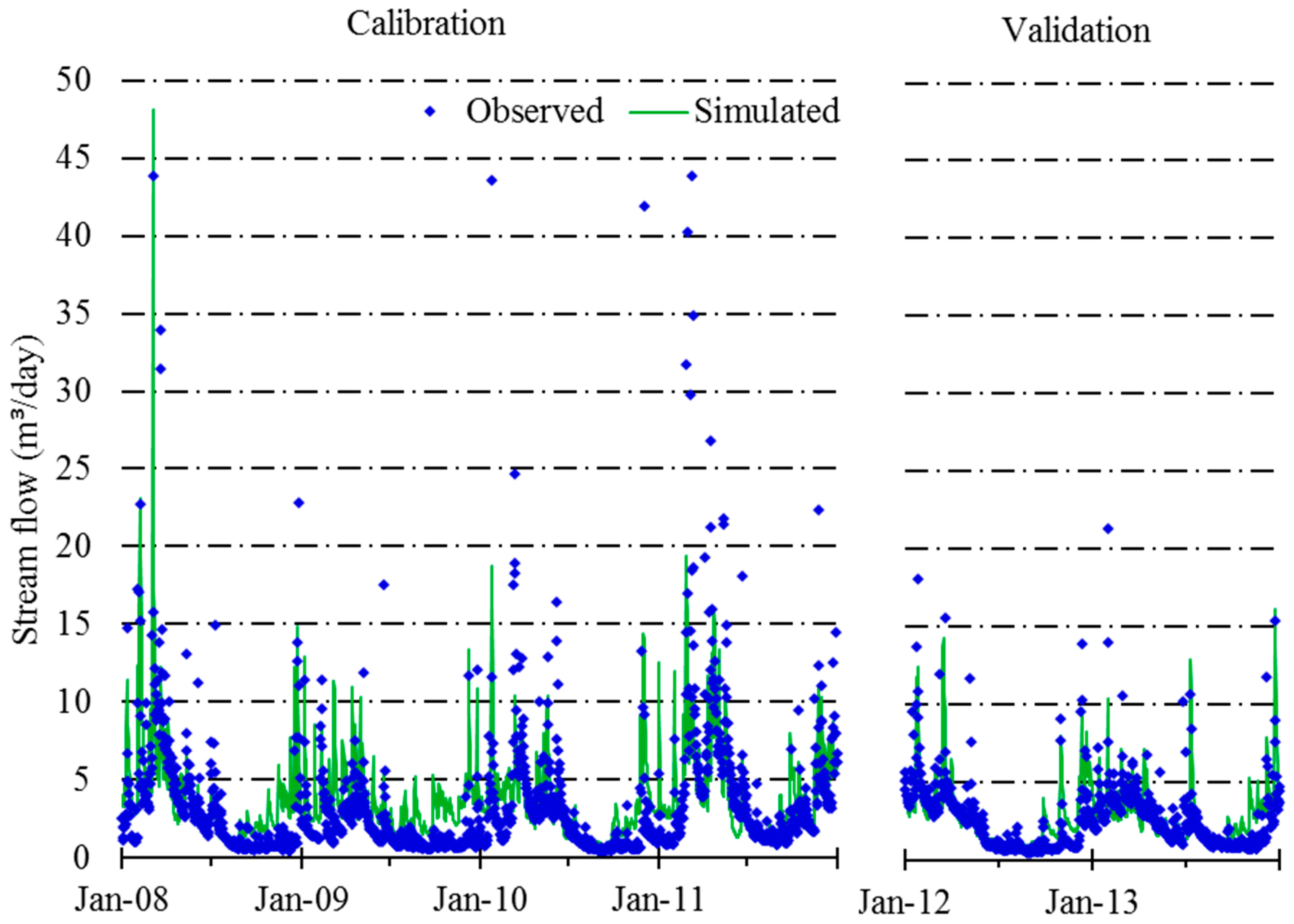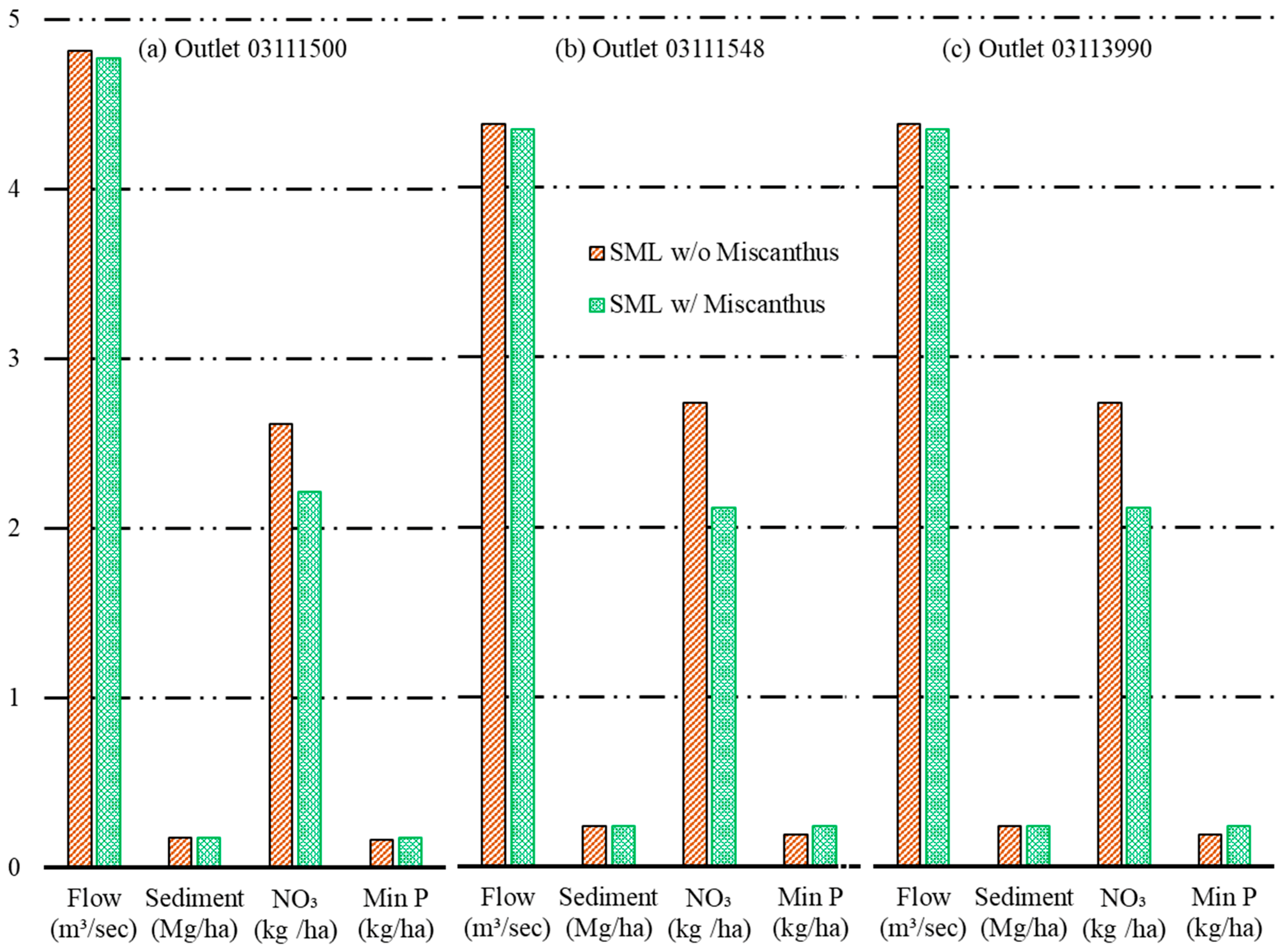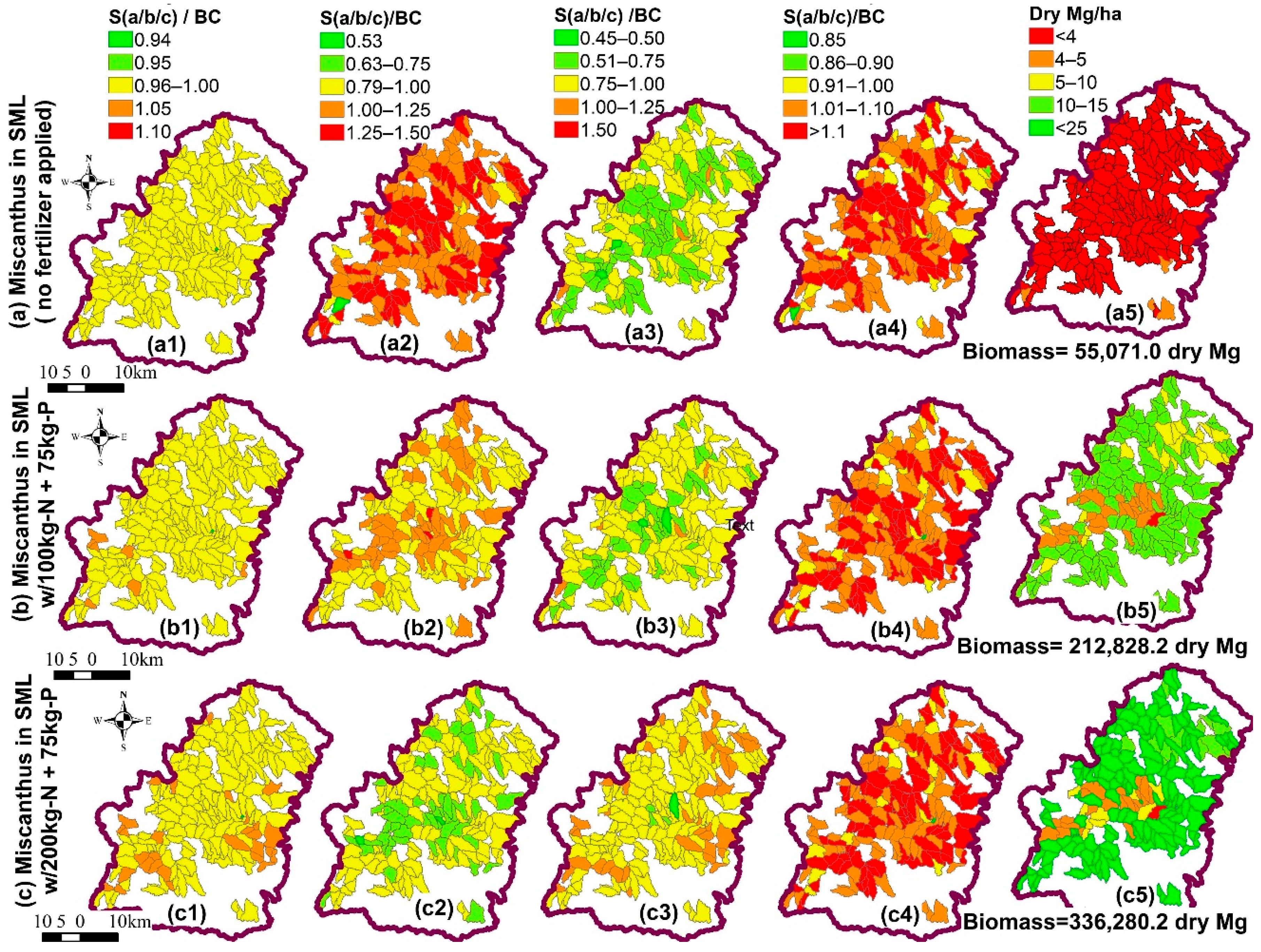Assessment of Miscanthus Yield Potential from Strip-Mined Lands (SML) and Its Impacts on Stream Water Quality
Abstract
1. Introduction
2. Methodology
2.1. Identification of Strip-Mined Land and Its Spatial Extent
2.1.1. Availability of Strip-Mined Land in the USA
2.1.2. Identification of SMLs Suitable for Miscanthus Cultivation
2.2. Study Area Descriptions
2.3. SWAT Model
2.4. Model Setup and Inputs
2.5. Crop Management Inputs to the SWAT Model
2.6. Model Evaluation
3. Results and Discussion
3.1. Model Calibration and Validation
3.2. Miscanthus Cultivation in SML Impacting Watershed
3.3. Miscanthus Biomass Availability
4. Conclusions
Supplementary Materials
Author Contributions
Funding
Acknowledgments
Conflicts of Interest
References
- Dale, B.E.; Anderson, J.E.; Brown, R.C.; Csonka, S.; Dale, V.H.; Herwick, G.; Jackson, R.D.; Jordan, N.; Kaffka, S.; Kline, K.L.; et al. Take a Closer Look: Biofuels Can Support Environmental, Economic and Social Goals. Environ. Sci. Technol. 2014, 48, 7200–7203. [Google Scholar] [CrossRef] [PubMed]
- Ussiri, D.A.N.; Lal, R. Miscanthus agronomy and bioenergy feedstock potential on minesoils. Biofuels 2014, 5, 741–770. [Google Scholar] [CrossRef]
- Sahoo, K.; Hawkins, G.L.; Yao, X.A.; Samples, K.; Mani, S. GIS-based biomass assessment and supply logistics system for a sustainable biorefinery: A case study with cotton stalks in the Southeastern US. Applied Energy 2016, 182, 260–273. [Google Scholar] [CrossRef]
- United States Congress. Energy Independence and Security Act of 2007. Available online: https://www.law.georgetown.edu/archiveada/documents/S3406FinalEngrossedVersion.pdf (accessed on 24 May 2018).
- Mai, T.; Wiser, R.; Barbose, G.; Bird, L.; Heeter, J.; Keyser, D.; Krishnan, V.; Macknick, J.; Millstein, D. A Prospective Analysis of the Costs, Benefits, and Impacts of US Renewable Portfolio Standards; National Renewable Energy Lab. (NREL): Golden, CO, USA, 2017.
- Langholtz, M.H.; Stokes, B.J.; Eaton, L.M.; Brandt, C.C.; Davis, M.R.; Theiss, T.J.; Turhollow, A.F., Jr.; Webb, E.; Coleman, A.; Wigmosta, M.; et al. 2016 Billion-Ton Report: Advancing Domestic Resources for A Thriving Bioeconomy. In Economic Availability of Feedstocks; ORNL/TM-2016/160; Oak Ridge National Laboratory: Oak Ridge, TN, USA, 2016; Volume 1. [Google Scholar]
- Qin, Z.; Zhuang, Q.; Cai, X. Bioenergy crop productivity and potential climate change mitigation from marginal lands in the United States: An ecosystem modeling perspective. GCB Bioenergy 2014, 7, 11. [Google Scholar] [CrossRef]
- Arundale, R.A.; Dohleman, F.G.; Heaton, E.A.; McGrath, J.M.; Voigt, T.B.; Long, S.P. Yields of Miscanthus × giganteus and Panicum virgatum decline with stand age in the Midwestern USA. GCB Bioenergy 2014, 6, 1–13. [Google Scholar] [CrossRef]
- Robertson, G.P.; Hamilton, S.K.; Barham, B.L.; Dale, B.E.; Izaurralde, R.C.; Jackson, R.D.; Landis, D.A.; Swinton, S.M.; Thelen, K.D.; Tiedje, J.M. Cellulosic biofuel contributions to a sustainable energy future: Choices and outcomes. Science 2017, 356, 9. [Google Scholar] [CrossRef] [PubMed]
- Skousen, J.; Zipper, C. Post-mining policies and practices in the Eastern USA coal region. Int. J. Coal Sci. Technol. 2014, 1, 135–151. [Google Scholar] [CrossRef]
- Office of Surface Mining Reclamation and Enforcement (OSMRE). Annual Report 2010–2011: Reclaiming Oversight, Reclaiming Communities; OSMRE: Washington, DC, USA, 2011. Available online: https://www.osmre.gov/resources/annualReports.shtm (accessed on 14 May 2018).
- Sahoo, K. Sustainable Design and Simulation of Multi-Feedstock Bioenergy. Ph.D. Thesis, University of Georgia, Athens, GA, USA, 2017. [Google Scholar]
- Cibin, R.; Trybula, E.; Chaubey, I.; Brouder, S.M.; Volenec, J.J. Watershed-scale impacts of bioenergy crops on hydrology and water quality using improved SWAT model. GCB Bioenergy 2016, 8, 837–848. [Google Scholar] [CrossRef]
- Feng, Q.; Chaubey, I.; Engel, B.; Cibin, R.; Sudheer, K.; Volenec, J. Marginal land suitability for switchgrass, Miscanthus and hybrid poplar in the Upper Mississippi River Basin (UMRB). Environ. Model. Softw. 2017, 93, 356–365. [Google Scholar] [CrossRef]
- Skousen, J.; Brown, C.; Griggs, T.; Byrd, S. Establishment and growth of switchgrass and other biomass crops on surface mines. J. Am. Soc. Min. Reclam. 2014, 3, 156. [Google Scholar]
- Skousen, J.; Keene, T.; Marra, M.; Gutta, B. Reclamation of mined land with switchgrass, miscanthus, and arundo for biofuel production. In Proceedings of the National Meeting of the American Society of Mining and Reclamation, WY Reclamation Across Industries, Lexington, Kentucky, 1–6 June 2013. [Google Scholar]
- Scagline, S.; Skousen, J.; Griggs, T. Switchgrass and Miscanthus Yields on Reclaimed Surface Mines for Bioenergy Production. J. Am. Soc. Min. Reclam. 2015, 4, 80–90. [Google Scholar] [CrossRef]
- Brown, C.; Griggs, T.; Keene, T.; Marra, M.; Skousen, J. Switchgrass Biofuel Production on Reclaimed Surface Mines: I. Soil Quality and Dry Matter Yield. Bioenergy Res. 2015, 9, 31–39. [Google Scholar] [CrossRef]
- Khanna, M.; Dhungana, B.; Clifton-Brown, J. Costs of producing miscanthus and switchgrass for bioenergy in Illinois. Biomass Bioenergy 2008, 32, 482–493. [Google Scholar] [CrossRef]
- Miguez, F.E.; Zhu, X.; Humphries, S.; Bollero, G.A.; Long, S.P. A semimechanistic model predicting the growth and production of the bioenergy crop Miscanthus x giganteus: Description, parameterization and validation. Glob. Chang. Biol. Bioenergy 2009, 1, 282–296. [Google Scholar] [CrossRef]
- Ng, T.L.; Eheart, J.W.; Cai, X.; Miguez, F. Modeling Miscanthus in the Soil and Water Assessment Tool (SWAT) to Simulate Its Water Quality Effects as a Bioenergy Crop. Environ. Sci. Technol. 2010, 44, 7138–7144. [Google Scholar] [CrossRef]
- Guzman, J.G.; Lal, R. Miscanthus and switchgrass feedstock potential for bioenergy and carbon sequestration on minesoils. Biofuels 2014, 5, 313–329. [Google Scholar] [CrossRef]
- Guzman, J.G.; Lal, R.; Byrd, S.; Apfelbaum, S.I.; Thompson, R.L. Carbon life cycle assessment for prairie as a crop in reclaimed mine land. Land Degrad. Dev. 2014, 27, 1196–1204. [Google Scholar] [CrossRef]
- Demissie, Y.; Yan, E.; Wu, M. Assessing Regional Hydrology and Water Quality Implications of Large-Scale Biofuel Feedstock Production in the Upper Mississippi River Basin. Environ. Sci. Technol. 2012, 46, 9174–9182. [Google Scholar] [CrossRef]
- Neitsch, S.L.; Arnold, J.G.; Kiniry, J.R.; Williams, J.R. Soil and Water Assessment Tool Theoretical Documentation Version 2009; Texas Water Resources InstituteTechnical Report No. 406; Texas A&M University System: College Station, TX, USA, 2011. [Google Scholar]
- Baskaran, L.; Jager, H.I.; Schweizer, P.E.; Srinivasan, R. Progress Toward Evaluating the Sustainability of Switchgrass as A Bioenergy Crop Using the Swat Model. Trans. ASABE 2010, 53, 1547–1556. [Google Scholar] [CrossRef]
- Feng, Q.; Chaubey, I.; Cibin, R.; Engel, B.; Sudheer, K.P.; Volenec, J.; Omani, N. Perennial biomass production from marginal land in the Upper Mississippi River Basin. Land Degrad. Dev. 2018, 29, 1748–1755. [Google Scholar] [CrossRef]
- National Research Council (NRC). Surface Mining: Soil, Coal, and Society: A Report/Prepared by the Committee on Soil as a Resource in Relation to Surface Mining for Coal, Board on Mineral and Energy Resources, Commission on Natural Resources, National Research Council; National Academy Press: Washington, DC, USA, 1981. [Google Scholar]
- Plass, W.T. History of surface mining reclamation and associated legislation. In Reclamation of Drastically Disturbed Lands; American Society of Agronomy: Madison, WI, USA, 2000; pp. 1–20. [Google Scholar]
- Mishra, U.; Torn, M.S.; Fingerman, K. Miscanthus biomass productivity within US croplands and its potential impact on soil organic carbon. GCB Bioenergy 2013, 5, 391–399. [Google Scholar] [CrossRef]
- Gronhovd, D.E.; Scott, D.F. Reclamation costs of strip-mined land in western North Dakota. North Dakota Farm Res. 1979, 37, 7–11. [Google Scholar]
- Ohio Department of Natutal Resource (ONDR). Mines of Ohio. Available online: https://gis.ohiodnr.gov/MapViewer/?config=OhioMines (accessed on 20 May 2018).
- Arnold, J.; Moriasi, D.; Gassman, P.; Abbaspour, K.; White, M.; Srinivasan, R.; Santhi, C.; Harmel, R.; Van Griensven, A.; Van Liew, M. SWAT: Model use, calibration, and validation. Trans. ASABE 2012, 55, 1491–1508. [Google Scholar] [CrossRef]
- Trybula, E.M.; Cibin, R.; Burks, J.L.; Chaubey, I.; Brouder, S.M.; Volenec, J.J. Perennial rhizomatous grasses as bioenergy feedstock in SWAT: Parameter development and model improvement. GCB Bioenergy 2015, 7, 1185–1202. [Google Scholar] [CrossRef]
- Texas A&M University. Global Weather Data for Swat. Available online: https://globalweather.tamu.edu/ (accessed on 28 April 2018).
- US Environmental Protection Agency. Clean Air Status and Trends Network (CASTNET). Available online: https://java.epa.gov/castnet/clearsession.do (accessed on 15 April 2018).
- Cibin, R.; Chaubey, I.; Engel, B. Simulated watershed scale impacts of corn stover removal for biofuel on hydrology and water quality. Hydrol. Process. 2012, 26, 1629–1641. [Google Scholar] [CrossRef]
- Milewski, A.; Sultan, M.; Yan, E.; Becker, R.; Abdeldayem, A.; Soliman, F.; Gelil, K.A. A remote sensing solution for estimating runoff and recharge in arid environments. J. Hydrol. 2009, 373, 1–14. [Google Scholar] [CrossRef]
- Abbaspour, K.C. SWAT-CUP: SWAT Calibration and Uncertainty Programs—A User Manual. Available online: http://www.neprashtechnology.ca/wp-content/uploads/2015/06/Usermanual_SwatCup.pdf (accessed on 28 April 2018).
- Moriasi, D.N.; Gitau, M.W.; Pai, N.; Daggupati, P. Hydrologic and Water Quality Models: Performance Measures and Evaluation Criteria. Trans. ASABE 2015, 58, 1763–1785. [Google Scholar]
- Love, B.J.; Nejadhashemi, A.P. Water quality impact assessment of large-scale biofuel crops expansion in agricultural regions of Michigan. Biomass Bioenergy 2011, 35, 2200–2216. [Google Scholar] [CrossRef]
- Dodds, W.K. Eutrophication and trophic state in rivers and streams. Limnol. Oceanogr. 2006, 51, 671–680. [Google Scholar] [CrossRef]
- Sahoo, K.; Mani, S.; Das, L.; Bettinger, P. GIS-based assessment of sustainable crop residues for optimal siting of biogas plants. Biomass Bioenergy 2018, 110, 63–74. [Google Scholar] [CrossRef]
- Haines, S.A.; Gehl, R.J.; Havlin, J.L.; Ranney, T.G. Nitrogen and Phosphorus Fertilizer Effects on Establishment of Giant Miscanthus. Bioenergy Res. 2015, 8, 17–27. [Google Scholar] [CrossRef]
- Leilei, R.; Ajay, K.B.; Stephen, K.H.; Robertson, G.P. Nitrogen fertilization challenges the climate benefit of cellulosic biofuels. Environ. Res. Lett. 2016, 11, 064007. [Google Scholar]
- Sahoo, K.; Mani, S. GIS based discrete event modeling and simulation of biomass supply chain. In Proceedings of the 2015 Winter Simulation Conference, Huntington Beach, CA, USA, 6–9 December 2015; Yilmaz, L., Chan, W.K.V., Moon, I., Roeder, T.M.K., Macal, C., Rossetti, M.D., Eds.; IEEE Press: Huntington Beach, CA, USA, 2015. [Google Scholar]
- Sahoo, K.; Mani, S. Economic and environmental impacts of an integrated-state anaerobic digestion system to produce compressed natural gas from organic wastes and energy crops. Renew. Sustain. Energy Rev. under review.
- Arundale, R.; Dohleman, F.; Voigt, T.; Long, S. Nitrogen Fertilization Does Significantly Increase Yields of Stands of Miscanthus × giganteus and Panicum virgatum in Multiyear Trials in Illinois. Bioenergy Res. 2014, 7, 408–416. [Google Scholar] [CrossRef]
- Keesstra, S.; Mol, G.; De Leeuw, J.; Okx, J.; Molenaar, C.; De Cleen, M.; Visser, S. Soil-Related Sustainable Development Goals: Four Concepts to Make Land Degradation Neutrality and Restoration Work. Land 2018, 7, 133. [Google Scholar] [CrossRef]









| USGS/EPA Station ID | Output | Calibration (2008−2011) | Validation (2012−2013) | |||||||||||
|---|---|---|---|---|---|---|---|---|---|---|---|---|---|---|
| Monthly | Daily | Monthly | Daily | |||||||||||
| NS | R2 | PBIAS | NS | R2 | PBIAS | NS | R2 | PBIAS | NS | R2 | PBIAS | |||
| 03111500 | Flow | 0.77 | 0.79 | −8.6 | 0.46 | 0.51 | −25.2 | 0.61 | 0.70 | 12.0 | 0.45 | 0.46 | −6.1 | |
| 03111548/C03S18 | 0.72 | 0.72 | −2.3 | 0.43 | 0.48 | −19.7 | 0.75 | 0.79 | −10.2 | 0.42 | 0.44 | −14.8 | ||
| 03113990 | 0.67 | 0.67 | −1.2 | 0.44 | 0.49 | −13.9 | 0.69 | 0.77 | 17.3 | 0.41 | 0.43 | 13.1 | ||
| 03111548/C03S18 | Sediment | 0.86 | 0.87 | −8.3 | 0.90 | 0.93 | 9.5 | |||||||
| 03111548/C03S18 | Nitrate (NO3-N) | 0.91 | 0.93 | 9.2 | 0.70 | 0.73 | 12.1 | |||||||
© 2019 by the authors. Licensee MDPI, Basel, Switzerland. This article is an open access article distributed under the terms and conditions of the Creative Commons Attribution (CC BY) license (http://creativecommons.org/licenses/by/4.0/).
Share and Cite
Sahoo, K.; Milewski, A.M.; Mani, S.; Hoghooghi, N.; Panda, S.S. Assessment of Miscanthus Yield Potential from Strip-Mined Lands (SML) and Its Impacts on Stream Water Quality. Water 2019, 11, 546. https://doi.org/10.3390/w11030546
Sahoo K, Milewski AM, Mani S, Hoghooghi N, Panda SS. Assessment of Miscanthus Yield Potential from Strip-Mined Lands (SML) and Its Impacts on Stream Water Quality. Water. 2019; 11(3):546. https://doi.org/10.3390/w11030546
Chicago/Turabian StyleSahoo, Kamalakanta, Adam M. Milewski, Sudhagar Mani, Nahal Hoghooghi, and Sudhanshu Sekhar Panda. 2019. "Assessment of Miscanthus Yield Potential from Strip-Mined Lands (SML) and Its Impacts on Stream Water Quality" Water 11, no. 3: 546. https://doi.org/10.3390/w11030546
APA StyleSahoo, K., Milewski, A. M., Mani, S., Hoghooghi, N., & Panda, S. S. (2019). Assessment of Miscanthus Yield Potential from Strip-Mined Lands (SML) and Its Impacts on Stream Water Quality. Water, 11(3), 546. https://doi.org/10.3390/w11030546







